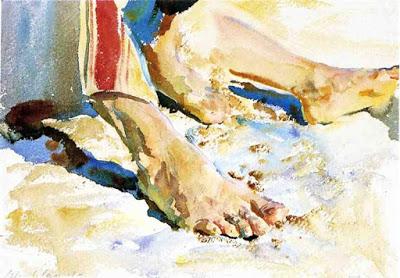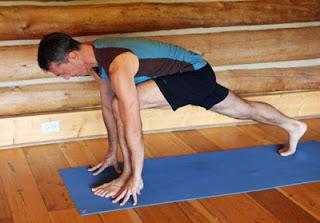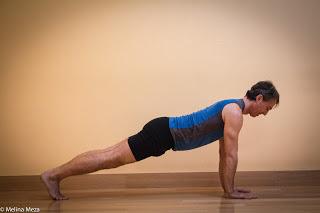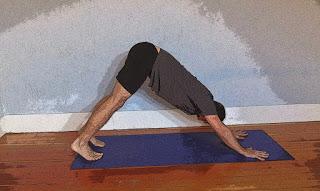
Feet of an Arab, Tiberius by John Singer Sargent
Q: My yoga teacher wants us to stand on the ball of our foot to enhance flexibility in the foot. I understand. But I have scar tissue on the bottom of my right foot after a neuroma operation--I gather this is common--and standing on the balls of my feet is painful. Is standing on the ball of my foot a good thing? A bad thing? It's painful but if I thought it was helpful, I would work with it.Follow up info: I've had this foot worked on a lot and the scar tissue IS reduced. But it's still there. So any thoughts you may develop—that will be interesting.
A: Let’s start by making sure we all know what this neuroma actually is. A Morton’s neuroma is a swelling and thickening of a nerve due to compression or pinching as it passes between two of the foot bones, the metatarsals. The most common spot is between the third and fourth metatarsals. As the neuroma develops, it can feel like a small lump on the ball of the foot, and is often painful to walk on or after prolonged standing.
There are a variety of non-surgical and surgical approaches to treatment. The initial conservative treatment typically includes stretches for the feet and toes in addition to other physical therapy and optional injection of medication. However, when the conservative approach fails, people will often turn to surgery to help resolve the problem. Surgery is usually an outpatient procedure and many people can return to fairly normal activity after about six weeks. Because each person’s course of recovery is unique, a physical therapist will customize the exercises given following surgery to fit the individual’s needs, which can include both stretching and strengthening exercises for the feet and toes. As with any surgical procedure, there can be unwelcome after effects, such as our reader notes, which can include scar tissue, stiffness, and even persistent pain.
Because our reader is trying to decide if it is worth standing on the balls of her feet even if that causes pain to her scar tissue area, let’s look at what the benefits of being able to come up onto the balls of your feet are. They include the following:
1. Increasing the flexibility of your toes and ankles (extension of toes where they meet the foot, of the metatarsal-phalangeal joint, and pointing the ankle, known as plantar flexion of the foot).
2. Strengthening the calf muscles.
3. Improving balance when on the balls of the feet (this can translate into everyday activity such as reaching for something on a high shelf, bounding up the stairs, or hopping up onto the curb when walking).
Although coming up onto the balls of your feet in yoga class is one way to create these benefits, there are other ways that might not trigger the pain from the scar tissue our reader experiences.
My first suggestion is to try a non-weight bearing pose, Reclined Hip Stretch Pose, version 1, with your leg straight up as an alternative to standing on the balls of your feet. While practicing Reclined Leg Stretch, place the strap across the toes of your lifted foot and press the ball of your foot up towards the ceiling (pointing your foot) while pulling down with the strap on your toes (extending your toes). By virtue of actively pressing the ball of your foot up, there will be some contraction of the calf muscles to help strengthen them while you are also improving flexibility in your foot.
From there, I’d suggest trying poses that create similar actions in your feet, but don’t require the standing with full weight of your body on your feet. Some examples include:
1. Lunge pose (see Featured Pose: Lunge Pose), which would focus mostly on extension of the toes of the back foot.



Another aspect of the yoga practice that might have a positive impact on the post-surgical area of the foot includes spreading your toes when in standing positions, as this has the potential to realign your toes in a more natural, out-of-shoes way that could make more room for the nerves as they pass between the toes, potentially decreasing the chances for a new neuroma to develop down the road.
Finally, although our reader is not asking for ways to resolve her persistent foot pain, I’d like to say that there could be other factors affecting persistent one-sided foot pain. So I always like to look closely down or up stream from where pain is occurring so as to not overlook an issue with a knee, hip, pelvis, lower back, etc., that could also be contributing to physical imbalances. So it could be very helpful for this reader to ask a yoga therapist or physical therapist to take a close look at them. For pain in general, I recommend you check out Yoga for Pain Management: The Big Picture.
I will also mention that I have had several students with persistent foot pain from a variety of causes (neuromas, plantar fascitis) who found that wearing a dedicated pair of shoes during yoga practice permitted them to do most of or all of their yoga practice without triggering their foot pain, I suspect by providing additional cushioning and support to the foot. So maybe give this a try.
And according to several colleagues who are physical therapists, releasing scar tissue, can improve flexibility, decrease stiffness and improve pain. (One massage technique, transverse friction massage, is reported to be quite effective but it is quite painful to receive.) You may also be able to gently release the scar tissue with appropriate poses I know from personal experience with what I suspect is some persistent scar tissue in my left shoulder that my practice of Downward-Facing Dog, while initially feeling stiff and achy in my left shoulder at the start of practice, often releases those sensations and improves my range of motion as I repeat the pose a few times. Although this has only a temporary effect (as I will feel the same restrictive sensations the next day at the start of practice), it still feels like it is helpful in maintaining my range of motion in the shoulder.
Although there are certain popular practices that have made their way into some yoga classes, like foam rollers and balls, that many claim to release scar tissue, there is actually no scientific evidence at this time to support this claim, even if there is a temporary decrease in pain in stiffness for some practitioners using these techniques. So I recommend you keep this in mind if you decide to try them out.
For those interested in learning more about scar tissue and yoga, check out this past post on the topic: Friday Q&A: Post-Surgery Scar Tissue.
—Baxter
To submit your own questions for our consideration, email them to baxterbell at mac dot com.Subscribe to Yoga for Healthy Aging by Email ° Follow Yoga for Healthy Aging on Facebook and Twitter ° To order Yoga for Healthy Aging: A Guide to Lifelong Well-Being, go to Amazon, Shambhala, Indie Boundor your local bookstore.
Follow Baxter Bell, MD on YouTube, Facebook, and Instagram. For upcoming workshops and retreats see Baxter's Workshops and for info on Baxter see baxterbell.com.
